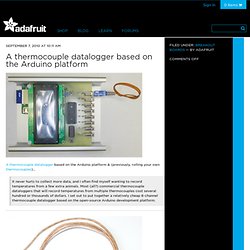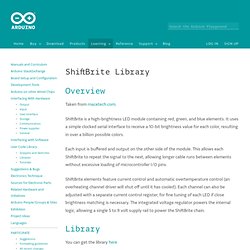

Energino: an Arduino-based energy consumption monitoring shield. Energino is a plug-load meter that measures the amount of power consumed by whatever DC electrical appliance is plugged into its.

It was originally designed to monitor the energy consumption of simple networking devices such as Ethernet switches and WiFi access points, but it can be used to monitor any DC appliance. Energino "sits" between the power supply and the actual device being monitored. Energino is also equipped with a mechanical relay allowing you to turn on/off whatever appliance that is plugged into it.
It has the following basic features: * Supported load voltage: 0-60V * Supported load current: 0-5A * Sampling rate: up to 5000 Hz * Sampling resolution (voltage): 60mV * Sampling resolution (current): 30mA Moreover, when used in combinations with an Ethernet shield it supports: Using Processing control LED Matrix (with 74HC595) A thermocouple datalogger based on the Arduino platform.
September 7, 2010 AT 10:11 am A thermocouple datalogger based on the Arduino platform & (previously, rolling your own thermocouples)… It never hurts to collect more data, and I often find myself wanting to record temperatures from a few extra animals.

Most (all?) Commercial thermocouple dataloggers that will record temperatures from multiple thermocouples cost several hundred or thousands of dollars. I set out to put together a relatively cheap 8-channel thermocouple datalogger based on the open-source Arduino development platform. Thermocouple Type-K Glass Braid Insulated – K. Robot Store. Phidgets Inc. - Unique and Easy to Use USB Interfaces.
A Multi-Protocol Infrared Remote Library for the Arduino. Do you want to control your Arduino with an IR remote?

Do you want to use your Arduino to control your stereo or other devices? This IR remote library lets you both send and receive IR remote codes in multiple protocols. It supports NEC, Sony SIRC, Philips RC5, Philips RC6, and raw protocols. If you want additional protocols, they are straightforward to add. The library can even be used to record codes from your remote and re-transmit them, as a minimal universal remote. To use the library, download from github and follow the installation instructions in the readme. How to send This infrared remote library consists of two parts: IRsend transmits IR remote packets, while IRrecv receives and decodes an IR message.
#include <IRremote.h> IRsend irsend; void setup() { Serial.begin(9600); } void loop() { if (Serial.read() ! This sketch sends a Sony TV power on/off code whenever a character is sent to the serial port, allowing the Arduino to turn the TV on or off. Minibloq.
Arduino Tutorials. Arduino Hacks. Temperature. Project-list. Arduino. Arduino. Arduino. Arduino. Arduino - HomePage. Processing.org. Make: Arduino. Online : LED cluster for Arduino testing. My friend Usman and I are collaborating long-distance on an Arduino project.

He’s a software guy (by which I mean he’s a guy actually made of software. OK, not really, but almost) and doesn’t have time right now to get up to speed on hardware. So, I send him bits of hardware as needed. This is how we did the RFID iConveyor project. In order for him to test sending signals to the Arduino’s digital out pins, I built this plug-in cluster of three LED with integrated resistors. They’re soldered to a set of four right-angle header pins, and all share ground. Related. Pulse Width Modulation (PWM) tutorial: 8051 example : 8051 Microcontroller Projects AVR PIC Projects Tutorials Ebooks Libraries codes.
►Idea Behind Implementation The basic idea behind PWM implementation on 8051 is using timers and switching port pin high/low at defined intervals.

As we have discussed in the introduction of PWM that by changing the Ton time, we can vary the width of square wave keeping same time period of the square wave. We will be using 8051 Timer0 in Mode 0. Values for high and low level will be loaded in such a way that total delay remains same. If for high level we load a value X in TH0 then for low level TH0 will be loaded with 255-X so that total remains as 255. ►Assembly Code Example ►Timer setup for PWM PWMPIN EQU P1.0 ; PWM output pinPWM_SETUP: MOV TMOD,#00H ; Timer0 in Mode 0 MOV R7, #160 ; Set pulse width control ; The value loaded in R7 is value X as ; discussed above. ►Interrupt Service Routine In your main program you need to call this PWM_SETUP routine and your controller will have a PWM output.
You can also make use of Timer1 if you want. ►Timer setup for PWM in C. Playground - ShiftBriteLib. Overview Taken from macetech.com.

ShiftBrite is a high-brightness LED module containing red, green, and blue elements. It uses a simple clocked serial interface to receive a 10-bit brightness value for each color, resulting in over a billion possible colors. Each input is buffered and output on the other side of the module. This allows each ShiftBrite to repeat the signal to the next, allowing longer cable runs between elements without excessive loading of microcontroller I/O pins. Seeed Studio Bazaar, Boost ideas, extend the reach. News. Adafruit Industries. Welcome.